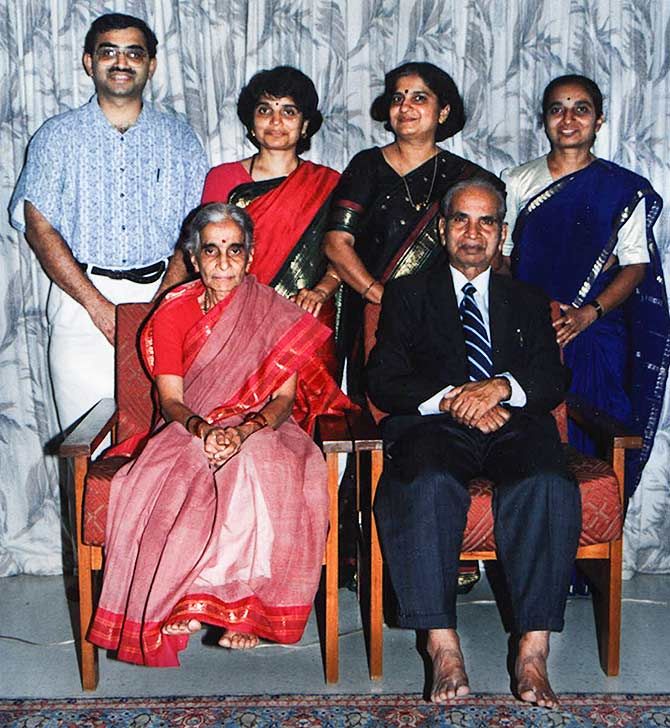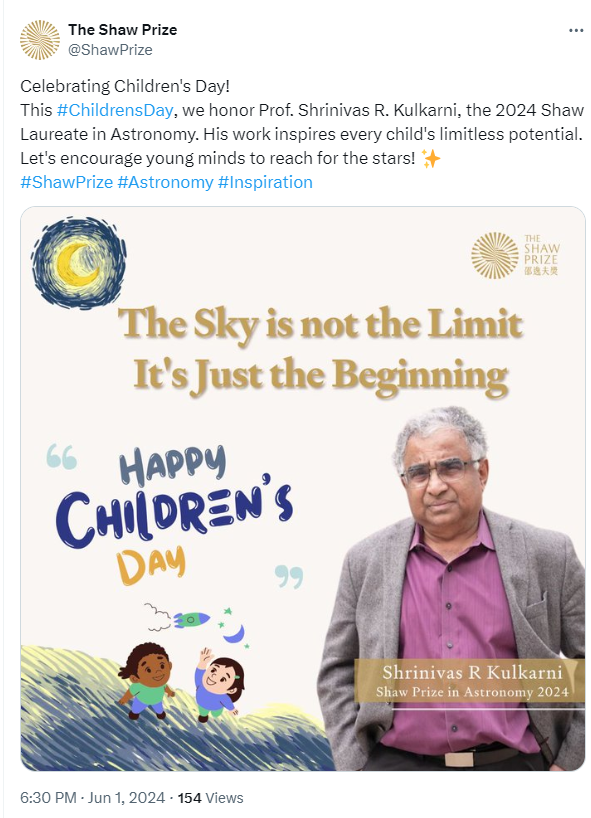(June 6, 2024) Having been the victim of his many pranks, Professor Shrinivas R. Kulkarni’s wife did not believe him at first when he told her that he had won the 2024 Shaw Prize in Astronomy. Instituted by the late Hong Kong philanthropist Run Run Shaw, the prize consists of a monetary award of $1.2 million. It was an occasion of joy not only at Kulkarni’s house in the US but also at the house of Infosys founder Narayana Murthy in India. Kulkarni is the brother of author, educator, and philanthropist Sudha Murty, better half of Narayana Murthy.
Shrinivas Kulkarni serves as the George Ellery Hale Professor of Astronomy and Planetary Science at the California Institute of Technology (Caltech). He has been awarded the 2024 Shaw Prize for his “ground-breaking discoveries about millisecond pulsars, gamma-ray bursts, supernovae, and other variable or transient astronomical objects,” states the Shaw Prize Foundation’s press release.

Professor Shrinivas Kulkarni
According to the award citation, “Kulkarni’s contributions culminated in the construction of the Palomar Transient Factory (PTF, 2009) and its successor, the Zwicky Transient Facility (ZTF, 2017), two novel astronomical surveys using a seventy-year-old telescope at Palomar Observatory in southern California.”
These projects have trained a new generation of young astronomers who are now at the forefront of time-domain astronomy. The extensive data generated by PTF and ZTF has facilitated the discovery of numerous astronomical transients and variable sources.
In fact, ‘ZTF has also found a star swallowing one of its planets’, discovered one of the closest and brightest supernovae ever recorded, a new category of orbital asteroids, binary stars with orbital periods as brief as seven minutes, which emit significant low-frequency gravitational radiation, and numerous other unique systems and rare events that are only now beginning to be comprehended.
“ZTF is only possible at Caltech, which values exceptionalism,” Professor Kulkarni remarked in a statement at Caltech’s website after the announcement of the Shaw Prize.
Career full of discoveries
Throughout his career, Kulkarni has made numerous groundbreaking discoveries. Among his early achievements are the discovery of the first millisecond pulsar—a rapidly rotating neutron star emitting over 600 precisely timed pulses per second—and the first brown dwarf, an extremely small star, identified in 1995 that bridges the gap between giant planets like Jupiter and hydrogen-burning stars like the Sun.
In 1997, Kulkarni and his colleagues were the first to measure the distance to a gamma-ray burst, revealing that this intense cosmic event originated billions of light-years away, far outside our galaxy.
Although the astronomer has made profound discoveries, he has a playful side to his personality, which became evident in one of his interviews. “We astronomers are supposed to say, ‘We wonder about the stars and we really want to think about it,'” he remarked, highlighting the perception about astronomers that they are deep thinkers. But he admitted that’s not entirely how it is. “Many scientists, I think, secretly are what I call ‘boys with toys,'” the Global Indian said. “I really like playing around with telescopes. It’s just not fashionable to admit it.”
Astronomical innovations
Kulkarni has been passionate about building instruments to explore uncharted areas in astronomy and has constructed around 10 astronomical instruments. “My motto has been to build a big enough gizmo and things will happen,” he said in one of his Caltech lecturers.
Every two days, his innovation ZTF scans the entire Northern sky, using automated software to analyse the data and an alert system to notify astronomers worldwide of transient events within minutes. The extensive data collected by PTF and ZTF has led to the discovery of a diverse array of astronomical transients and variable sources.
These projects were funded by institutions worldwide and two major grants – one from the National Science Foundation and the other from the Heising-Simons Foundation.
Earlier in his career, working with a graduate student, the professor and astronomer had developed STARE2, an instrument to study fast-radio bursts (FRBs)– the mysterious bursts of radio waves whose origins were unknown. In 2020, STARE2 was among two telescopes that identified an FRB originating from a dead magnetic star called magnetar, marking the initial confirmation that dead magnetic stars can produce FRBs.
Powerful women in his life
After earning a master’s degree from the IIT-Delhi in 1978, Kulkarni had moved to the US for a PhD in astronomy at UC Berkeley. It was during this time there that he had met Hiromi Komiya, a doctoral student from Japan, and fallen in love with her. Within just a few weeks, he quickly learned Japanese and won her heart. They got married and the couple has two daughters – Anju and Maya.
Being the youngest, Kulkarni has always been in awe of his three elder sisters. His eldest sister Sunanda followed in their father’s footsteps and served as gynaecologist at a government hospital in Bangalore. Sudha Murthy, head of the Infosys Foundation is a celebrated author, educator and philanthropist. While his younger sister Jayshree, an IIT-Madras alumnus is married to Boston-based IT billionaire Gururaj ‘Desh’ Deshpande. “All my sisters were gold medallists and evolved into competent professionals,” he remarked in one his interviews. “Coming from such a family, I found it strange that there were so few women in high places in the US when I first moved to that country,” he remarked.

Shrinivas Kulkarni in an old family picture with his parents and sisters Jayashree, Sudha and Sunanda | Photo Credit: rediff.com
In love with astronomy
“As a child I had a lot of fascination for astronomers,” shared Kulkarni in one of the interviews. Born in the small town of Kurundwad in Maharashtra, Kulkarni moved to Hubli in Karnataka due to his father’s transfer as a government doctor and ended up completing his schooling. He later attended IIT Delhi for an integrated BSc and MSc programme before moving to the US for a PhD in astronomy.
“I wanted to do research and not go into industry or be a doctor or lawyer or engineer which is sort of the more traditional path,” he shared in an interview. At Berkeley, he specialised in radio astronomy. “I had an exceptional advisor who understood what I really wanted to do,” he said.
After completing his PhD in 1983, he went for post-doctoral research at Caltech on a Millikan Fellowship, marking the beginning of an impressive 40 years of association with the institution.
He joined Caltech as a faculty member in 1987, progressing from assistant professor of astronomy to associate professor, professor, professor of astronomy and planetary science, MacArthur Professor, and eventually the George Ellery Hale Professor of Astronomy and Planetary Science. He also served as executive officer for astronomy and director of Caltech Optical Observatories, and oversaw the Palomar and Keck telescopes, two of the international astronomy community’s most prized instruments.
Professor Shrinivas Kulkarni’s passion for astronomy has made him one of the most widely acclaimed award-winning astronomers in the world. Over his four-decade career, he has received numerous honours, including the Presidential Young Investigator Award, the US National Science Foundation’s Alan T. Waterman Prize, the Dan David Prize, the Jansky Prize, and the Helen B. Warner Award, and now the Shaw Prize. He enjoys receiving awards because, as he believes, “Awards open doors.”
Read a similar story of:
V. Narayanan, new ISRO chief aims to boost India’s Space research.
Nandan Nilekani, the visionary behind India’s digital revolution.






This article provides a sophisticated and insightful examination of the topic. The thoroughness of your research and the clarity of your presentation offer readers a valuable perspective. Your professional writing style and attention to detail are evident, making this post an exemplary contribution to the discussion. I appreciate the depth and quality of your analysis.